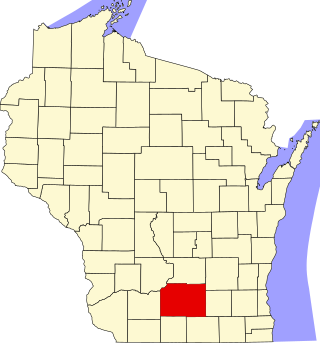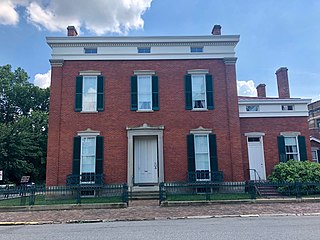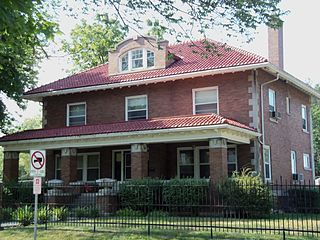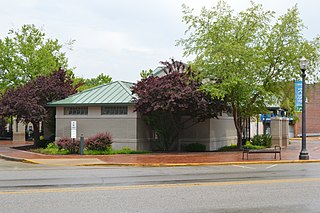
Edwardsville is a city in and the county seat of Madison County, Illinois, United States. As of the 2020 census, the population was 26,808. The city was named in honor of Ninian Edwards, former Governor of the Illinois Territory. Edwardsville is a part of Southern Illinois and the Metro East region within Greater St. Louis, located 18 miles (29 km) northeast of downtown St. Louis.

This is a list of sites in Minnesota which are included in the National Register of Historic Places. There are more than 1,700 properties and historic districts listed on the NRHP; each of Minnesota's 87 counties has at least 2 listings. Twenty-two sites are also National Historic Landmarks.

This is a list of the National Register of Historic Places listings in Dane County, Wisconsin. It aims to provide a comprehensive listing of buildings, sites, structures, districts, and objects in Dane County, Wisconsin listed on the National Register of Historic Places.

This page is about the historic Madison Indiana house. For the historic home in west Virginia, see: Samuel Shrewsbury Sr. House

The Green–Meldrim House is a historic house at 14 West Macon Street, on the northwest corner of Madison Square, in Savannah, Georgia. Built in 1853, it was designated as a National Historic Landmark in 1976 as one of the American South's finest and most lavish examples of Gothic Revival architecture. The house is owned by the adjacent St. John's Episcopal Church, which offers tours and uses it as a meeting and reception space.

Rose Hill Manor, now known as Rose Hill Manor Park & Children's Museum, is a historic home located at Frederick, Frederick County, Maryland. It is a 2+1⁄2-story brick house. A notable feature is the large two-story pedimented portico supported by fluted Doric columns on the first floor and Ionic columns on the balustraded second floor. It was the retirement home of Thomas Johnson (1732–1819), the first elected governor of the State of Maryland and Associate Justice of the United States Supreme Court. It was built in the mid-1790s by his daughter and son-in-law.

Cottage Lawn is a historic home located at Oneida in Madison County, New York. It is a Gothic Revival style cottage designed by Alexander Jackson Davis and built in 1849. It is a two-story L-shaped house, with basement and attic. It is constructed of brick and coated in stucco. It features six quatrefoil columns that support Tudor arches spanning the verandah.

The Arthur Ebeling House is a historic building located on the west side of Davenport, Iowa, United States. The Colonial Revival house was designed by its original owner, Arthur Ebeling. It was built from 1912 to 1913 and it was listed on the National Register of Historic Places in 1984.

Ferry & Clas was an architectural firm in Wisconsin. It designed many buildings that are listed on the National Register of Historic Places. George Bowman Ferry and Alfred Charles Clas were partners.

The Elijah P. Curtis House is a historic house located at 405 Market Street in Metropolis, Illinois. The Classical Revival house was built in 1870 for Elijah P. Curtis. The house was added to the National Register of Historic Places in 1978 and now houses the Massac County Historical Museum.

Saint Leonard Catholic Church is a Roman Catholic church in the city of Madison, in the state of Nebraska in the Midwestern United States. Built in 1913, it has been described as "an outstanding example of the Romanesque Revival style of architecture."

The Madison County Sheriff's House and Jail was a historic house and jail building located at 210 N. Main St. in Edwardsville, Illinois. Built in 1869 and opened in 1871, the building was the oldest Madison County government building in Edwardsville, the county seat. The building consisted of a three-story sheriff's house and an adjacent cell block; the cell block was expanded in 1904 to provide space for female prisoners. The sheriff's house was designed in the Second Empire style; it was one of two examples of the style in Edwardsville and the only one which had maintained its historical appearance. The building's design featured a mansard roof, two dormers on both the front and rear sides, and a bracketed wooden cornice.

Oak Place is a historic residence in Huntsville, Alabama. It was built by renowned Huntsville architect George Steele in 1840 on 320 acres. Steele designed a number of buildings across the South, including the First National Bank building in Huntsville, and the second Madison County Courthouse, which stood from 1840 until 1914. Similar to many of his buildings, Steele designed the Oak Place house in a Greek Revival style, although much more restrained in detail.

The John Daniel Rather House is a historic residence in Tuscumbia, Alabama, United States. The house was built in 1823 by William H. and Catherine Winter, who came to The Shoals from Prince William County, Virginia. It was taken over by the Union Army during the Civil War and used as the headquarters of General Florence M. Cornyn. After the war, the house was purchased by John Taylor Rather, an early North Alabama settler who was deputy sheriff of Madison County, and a longtime member of the Alabama House of Representatives and later the Alabama Senate. His son, John Daniel Rather, also served in both houses of the state legislature, and was President of the Memphis and Charleston Railroad.

Nash Law Office is a historic office building located at Hillsborough, Orange County, North Carolina. It was built in 1801, and is a small one-story, frame building with a gable roof and low brick foundation. It has a brick exterior end chimney and a small one-story wing added in 1865. The building housed the law office of jurist Frederick Nash (1781-1858). Following his death it housed a school and was purchased by the Hillsborough Historical Society in 1970.
Indian Fish Trap State Preserve, also known as the Indian Fish Weir, is a historic site located near the Amana Colonies in rural Iowa County, Iowa. The fish weir is an array of rocks in a V-shaped formation in the Iowa River. It is the only structure of this kind in Iowa.

The C.D. Bevington House and Stone Barn are historic buildings located in Winterset, Iowa, United States. Bevington was a pharmacist who passed through the area in 1849 on his way to the California Gold Rush. He settled in Winterset in 1853 after he made his fortune, and worked as a real estate agent and farmer. The house was built in the vernacular Gothic in 1856. The 2½-story brick structure features Gothic windows in the gable ends and carved bargeboards. The two porches were added around the turn of the 20th century. The two-story barn is composed of coursed rubble limestone. The lower level housed two horse stalls and stanchions for other livestock. A hay loft was on the upper level. The house and barn were listed on the National Register of Historic Places in 1976. Both buildings were donated to the Madison County Historical Society and are part of their museum complex.

The John Wilder House is a historic house on Lawrence Hill Road in the village center of Weston, Vermont. Built in 1827 for a prominent local politician, it is a distinctive example of transitional Federal-Greek Revival architecture in brick. Some of its interior walls are adorned with stencilwork attributed to Moses Eaton. The house was listed on the National Register of Historic Places in 1983.

The District No. 8 School, also known locally as the Brick School, is a historic school building on United States Route 7 in Georgia, Vermont. Built in 1891, it was one of the last district schools to be built in the state, which mandated town control over schools the following year. It now houses the collection of the Georgia Historical Society and is known as the Brick Schoolhouse Museum. It was listed on the National Register of Historic Places in 1998.

The East Wilson Street Historic District includes remnants of businesses that grew around two railroad depots a half mile east of the capitol in Madison, Wisconsin, starting in the 1860s. A cluster of the hotel and saloon buildings from this district are still fairly intact, in contrast to Madison's other railroad station on West Washington. In 1986 the district was listed on the National Register of Historic Places and the State Register of Historic Places in 1989.





















